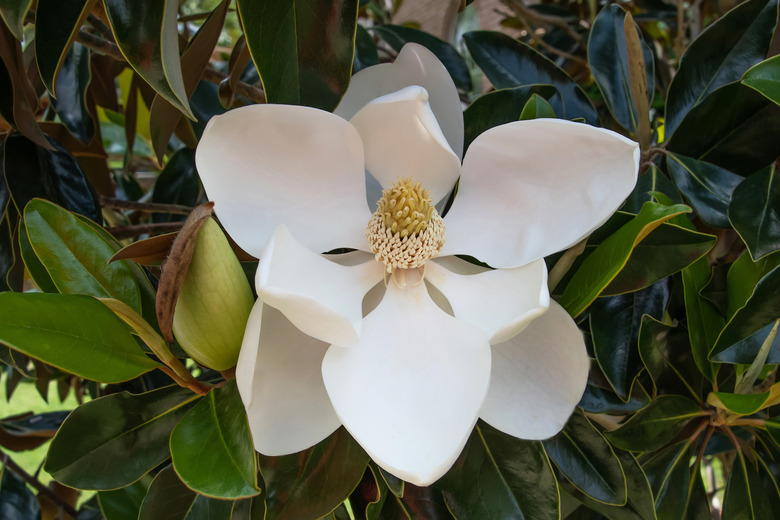The Growth Rate Of Little Gem Magnolias
Magnolia grandiflora 'Little Gem' grows to a height of approximately 35 feet. It attains a width of up to 12 feet. A broad-leaved evergreen, the Little Gem produces a symmetrical, dense canopy composed of dark green, leathery leaves that exhibit a furry bronze underside. Each oval leaf measures up to 8 inches in length. The tree exhibits no fall colors but does hold its bright green leaf colors throughout the winter.
Little Gem Magnolia Yearly Flower Production
At approximately two to three years, the Little Gem magnolia begins to produce blooms. The creamy white flowers appear during the summer. The blossoms produce a sweet fragrance. Each one measures up to 8 to 12 inches in diameter. The flowers appear at the ends of the tree's stems and stand out in stark contrast against the foliage of the tree. Following flowering, cones appear. Each cone measures up to 6 inches in length. The cones sport bright red seeds that draw an abundance of birds. The Little Gem does produce viable seeds, but the seedlings often differ in appearance from the parent tree.
Little Gem Growth Expectations
The dwarf tree's shrublike growth and slow growth rate make it ideal as a container specimen on a patio or deck. The Little Gem magnolia grows approximately 1 to 2 feet per year. Planting several of the trees forms a dense hedge. The Little Gem magnolia also grows well when formed into an espalier. It does not transplant well once established because it grows a wide root system that often extends up to four times the width of the tree's canopy. The Little Gem does suffer from root girdling. Remove any roots that appear wrapped around the root ball at the time of planting. Transplant the Little Gem in the winter or spring.
Planting Little Gem Magnolias
Little Gem magnolia grows best in full sunlight but tolerates partial shade. The tree does not withstand a wet root system well and may succumb to ongoing drought conditions. Avoid planting the Little Gem in locations that have hot, dry weather. The tree prefers acidic soil but withstands only slightly acidic conditions. Keep the tree moist after planting but not overly wet.
Potential Issues With Little Gem Magnolias
Scale insects often plague the Little Gem magnolia. Scales use their powerful mouths to suck the tree's nutrients. The immobile scales encase themselves in a waxy substance along the tree's stems. Beneath the protection they feed on the tree's sap. Use horticultural oils to control scales. The tulip-poplar weevil feeds on the tree's foliage and causes unsightly holes to appear. Control using an insecticidal spray. Canker growths can appear on the Little Gem's limbs. Prune away any areas that suffer cankers and dispose them. The tree's foliage can also suffer black mold or leaf spot diseases. Promptly rake up all infected foliage from beneath the tree and dispose of it. Consider using a fungicide to control the disorder.
References
- University of Florida IFAS Extension; Magnolia Grandiflora "Little Gem"; Edward F. Gilman, et al.; November 1993
- Missouri Botanical Garden: Magnolia Grandiflora "Little Gem"
- North Carolina State University: Magnolia Grandiflora "Little Gem"
- Fast Growing Trees Nursery: Little Gem Magnolia
- University of Kentucky College of Agriculture; Magnolia Scale; Lee Townsend; March 2005
- University of Kentucky College of Agriculture; Yellow Poplar Weevil; Lee Townsend; January 1994
